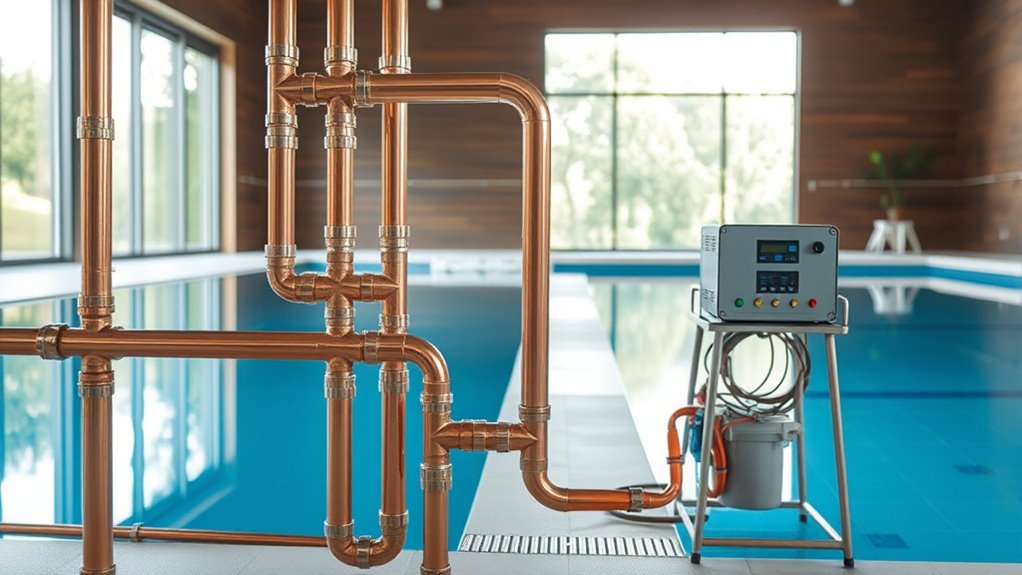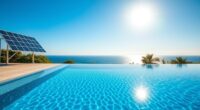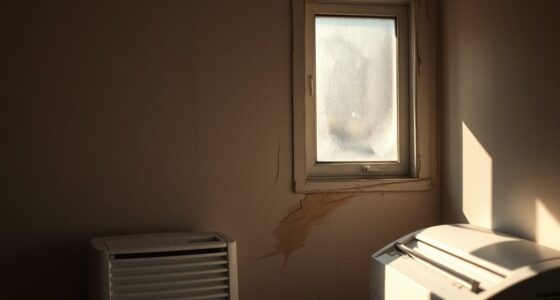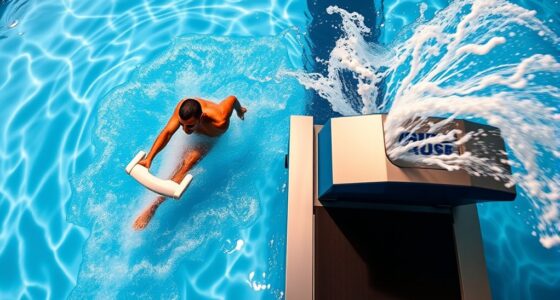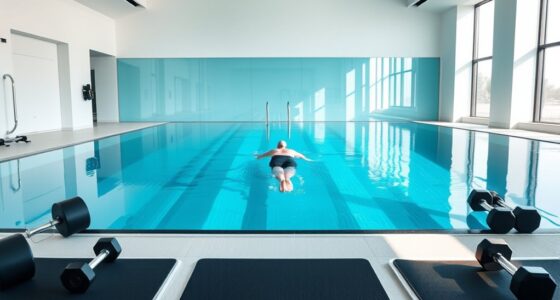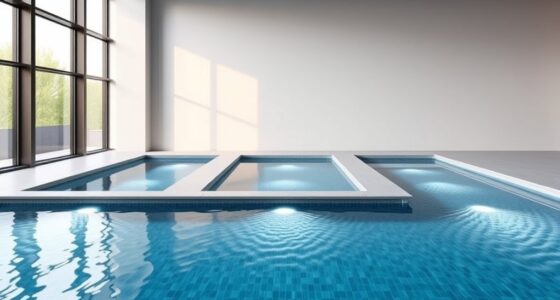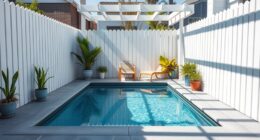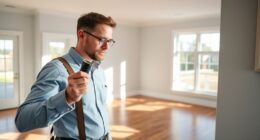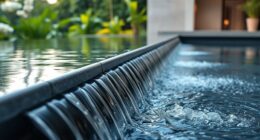To set up an endless pool, you’ll need a reliable pump and heater system for water circulation and temperature control. Proper plumbing involves selecting appropriately sized pipes and a layout that ensures efficient water flow and filtration. You should also meet electrical requirements with dedicated circuits and secure wiring to handle the load safely. Paying attention to safety features and leak prevention is essential. Keep exploring to discover detailed tips for building a seamless plumbing and power setup.
Key Takeaways
- Install a dedicated electrical circuit (30-50 amps) with GFCI protection for safe, reliable power supply.
- Position the pump near return jets and elevate it above water level to ensure optimal circulation and ease of maintenance.
- Select a compatible filter and plumbing layout with straight pipes and minimal bends to maximize flow efficiency.
- Connect the heater downstream of the pump, ensuring flow rate matches the heater’s specifications for consistent heating.
- Secure leak prevention measures and vibration-absorbing mounts to maintain safety, reduce noise, and prolong system lifespan.
Essential Water Circulation and Filtration Components
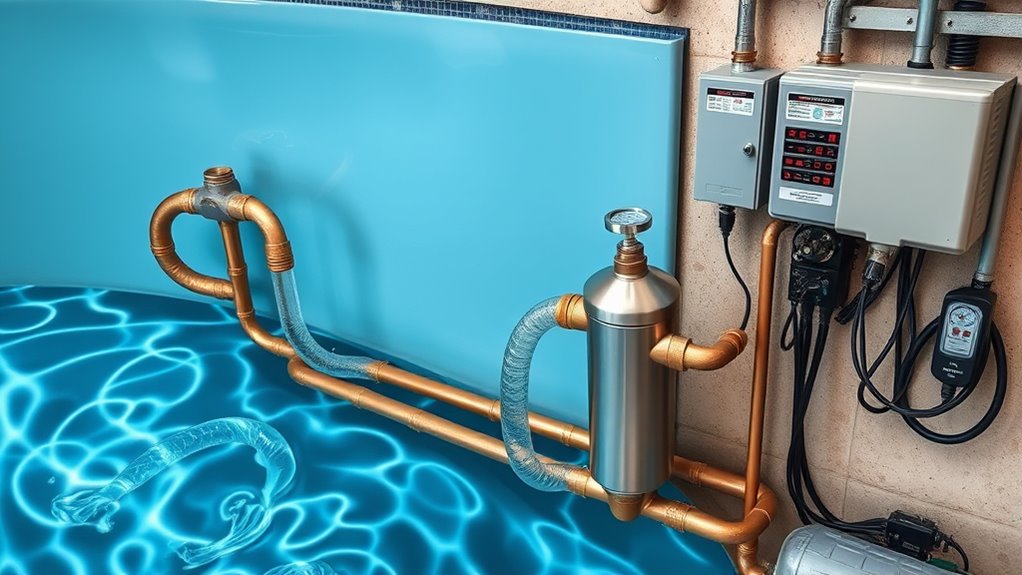
To keep your Endless Pool clean and functioning smoothly, you need reliable water circulation and filtration components. These are vital for maintaining water clarity, quality, and safety. A good pump ensures continuous movement, preventing stagnation and distributing chemicals evenly. The filter traps dirt, debris, and contaminants, keeping your water sparkling and healthy. Choose a filter suitable for your pool size and usage frequency, and make sure it’s easy to access for regular maintenance. Proper placement of the pump and filter is essential to maximize efficiency and minimize noise. Regularly inspecting and cleaning these components prevents buildup and prolongs their lifespan. Additionally, selecting certified equipment can help ensure compatibility and optimal performance. By investing in quality circulation and filtration equipment, you guarantee your Endless Pool stays pristine and ready for use at any time.
Pump and Heater Configuration
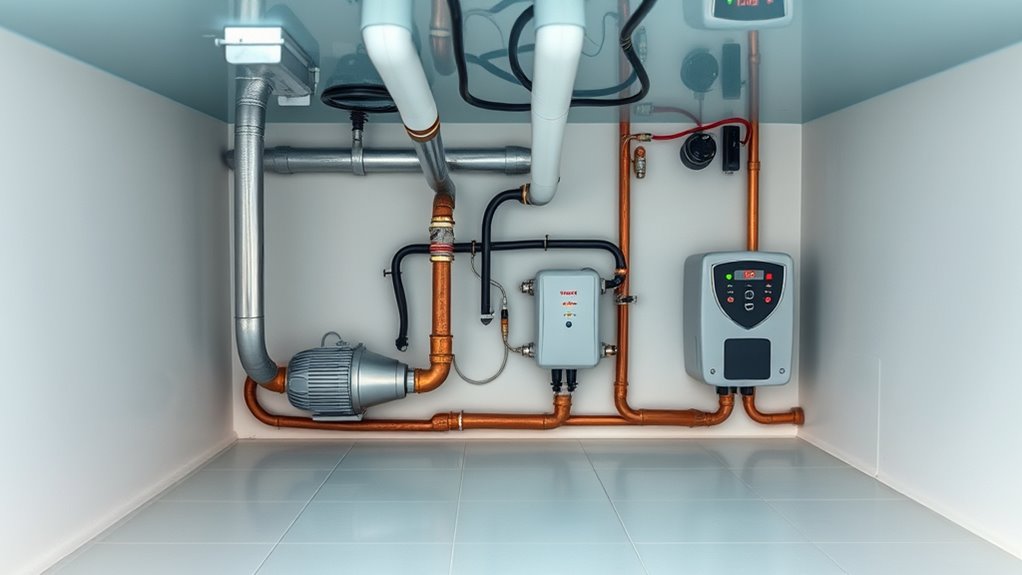
Proper pump placement guarantees efficient water flow and easy access for maintenance. When choosing a heater, make sure it’s compatible with your pump and fits your pool setup. Ensuring your system has the appropriate installation requirements is crucial for optimal performance and safety. Let’s explore tips for positioning your pump and selecting the right heater options.
Pump Placement Tips
Ensuring your pump and heater are correctly positioned is vital for ideal pool performance. Proper placement maximizes efficiency and prevents issues like airlocks or uneven flow. First, position the pump close to the pool’s return jets to guarantee smooth circulation. Second, elevate the pump slightly above the water level to avoid air entering the system, which can cause cavitation. Third, place the heater downstream of the pump to certify it heats the water evenly before returning to the pool. Use sturdy, vibration-absorbing mounts to reduce noise and movement. Keep hoses short and straight to minimize pressure loss. Additionally, selecting compatible paint sprayer accessories ensures optimal performance and finish quality. By following these tips, you’ll optimize water flow, maintain equipment longevity, and enjoy a hassle-free swimming experience.
Heater Compatibility Options
Choosing the right heater compatibility options depends on your pump and pool setup. First, verify your pool’s flow rate to guarantee the heater can handle the volume without strain. Most heaters specify a maximum flow rate; exceeding this can cause damage or inefficiency. Compatibility also depends on the type of heater—gas, electric, or heat pump—and their connection fittings. Some heaters are designed for direct connection to specific pump models, while others may require adapters. Consider the placement as well; for optimal efficiency, the heater should be installed close to the pump to reduce heat loss and piping length. Always check manufacturer guidelines to confirm compatibility before purchasing, ensuring your setup runs smoothly and heats effectively. Recognizing inspirational quotes about fatherhood can remind you of the importance of support and guidance in all aspects of life, including setting up your pool system efficiently.
Plumbing Layout and Pipe Sizing
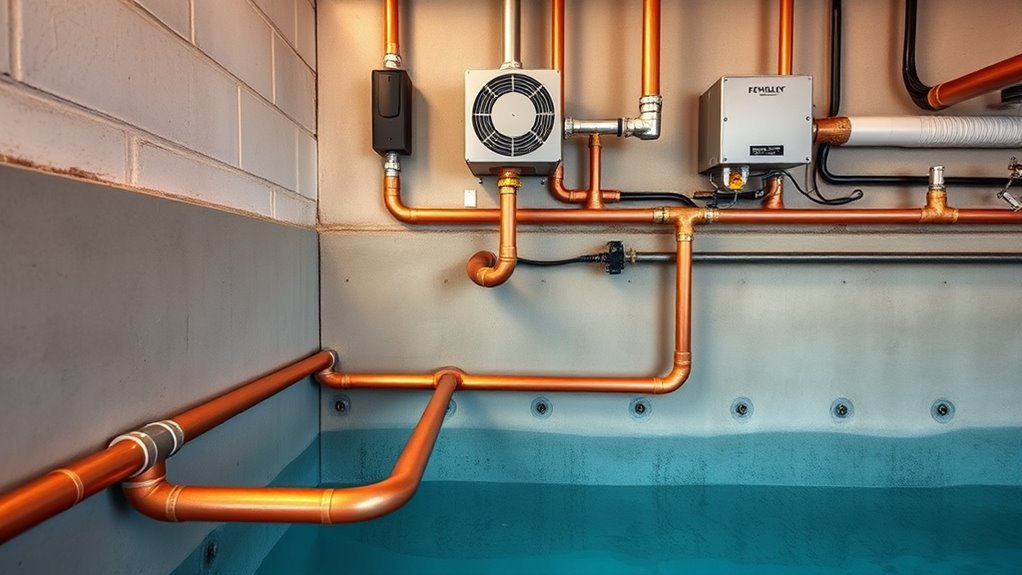
To guarantee your Endless Pool functions efficiently, you need to focus on ideal pipe routing and correct pipe sizing. Proper layout prevents water flow issues, while the right pipe size maintains consistent pressure. Getting these details right now saves you trouble later on. Additionally, considering space optimization can help in designing a more efficient and accessible plumbing setup.
Optimal Pipe Routing
Optimizing pipe routing is essential for creating an efficient and reliable plumbing system for your Endless Pool. Properly planned routes reduce pressure drops, minimize noise, and prevent leaks. To achieve this, focus on logical, direct paths for your pipes, avoiding unnecessary bends and long runs. Keep the pipes close to the pool and main equipment to reduce friction and maintain flow. Use smooth, high-quality fittings to guarantee seamless connections. Additionally, considering proper gear shifting techniques can help ensure the longevity and smooth operation of your system components.
Consider these key points:
- Route pipes in a straight line whenever possible to ensure smooth water flow.
- Keep pipe lengths minimal to reduce pressure loss.
- Avoid sharp bends that can cause turbulence and restrict flow.
Smart routing enhances overall system performance and simplifies future maintenance.
Correct Pipe Sizing
Selecting the correct pipe size is essential for ensuring efficient water flow and system performance in your Endless Pool setup. If the pipes are too small, water flow slows down, increasing pressure and risking leaks or damage. Conversely, pipes that are too large can lead to unnecessary costs and complicate installation. To determine the right size, consider your pool’s flow rate and the distance water needs to travel. Generally, 1.5-inch pipes work well for most residential setups, providing a balance of flow and ease of installation. Always follow manufacturer guidelines and local codes. Proper pipe sizing minimizes pressure drops and guarantees consistent water circulation, helping your Endless Pool operate smoothly and efficiently for years. Proper pipe sizing is crucial for preventing system inefficiencies and ensuring safe operation.
Electrical Power Requirements and Wiring
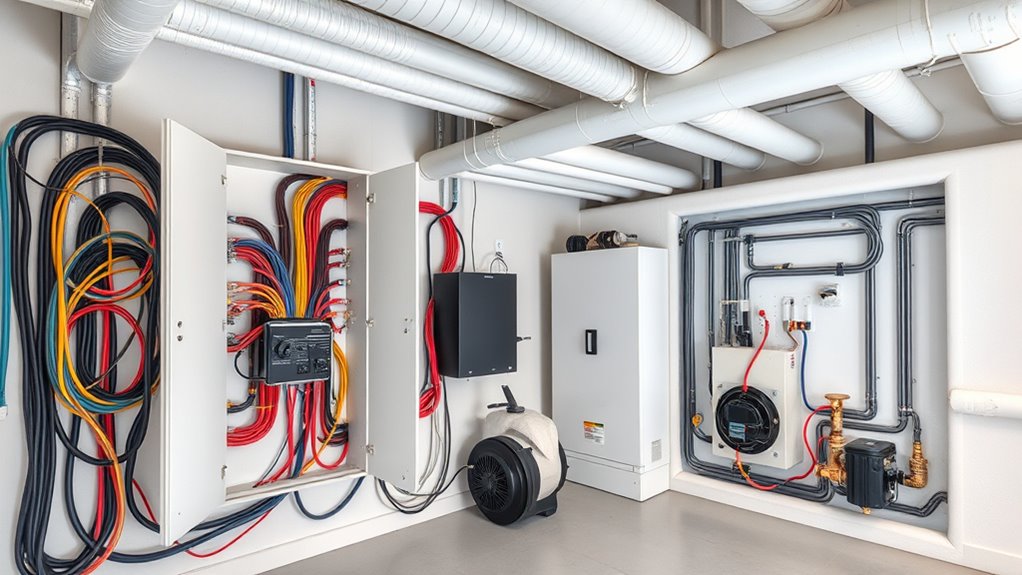
What electrical power requirements does your Endless Pool need to operate safely and efficiently? Your setup typically demands a dedicated circuit to handle the load, guaranteeing stable power delivery. You’ll need a circuit breaker rated for the pool’s motor and heater, usually between 30 to 50 amps. Proper wiring is essential—thick, insulated cables run directly from your main panel to the pool’s control box. Visualize this:
- Thick, color-coded wires snaking through your basement or utility room
- A dedicated, labeled breaker in your electrical panel
- Secure connections that prevent shorts and ensure steady power flow
Ensuring these components are correctly installed minimizes risks and keeps your pool running smoothly, providing a safe, efficient aquatic experience.
Safety Features and Leak Prevention Measures
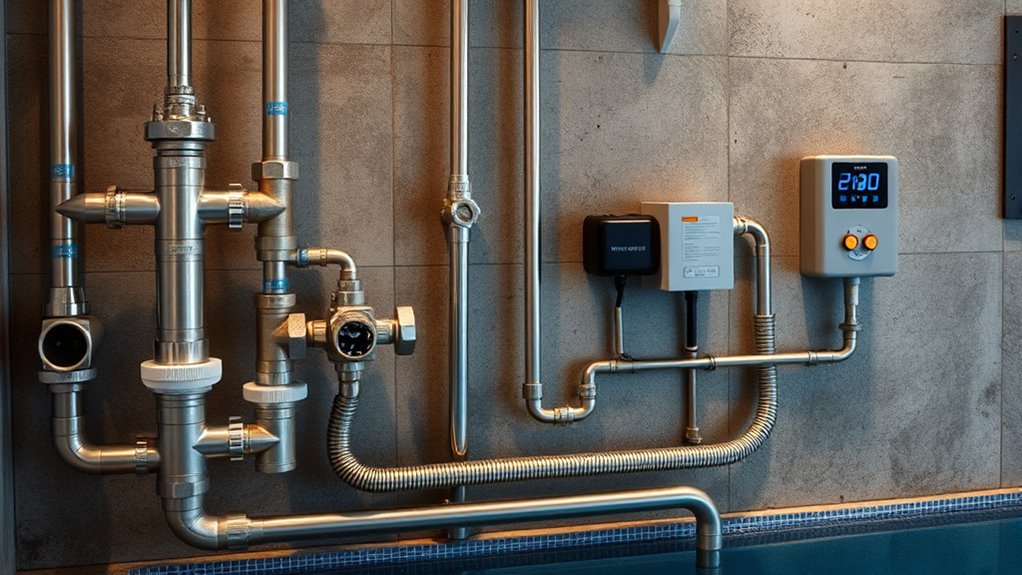
Ensuring your Endless Pool operates safely involves more than just proper wiring and power setup; it also requires effective safety features and leak prevention measures. You should install a reliable ground-fault circuit interrupter (GFCI) to prevent electrical shocks. Incorporate a high-quality, automatic shut-off system that activates if leaks are detected or if water levels drop unexpectedly. Use leak detection sensors around pump connections and along the pool’s perimeter to catch issues early. Ensure all plumbing joints are tightly sealed with appropriate fittings and waterproof sealants. Regularly inspect hoses, fittings, and seals for signs of wear or damage. By taking these precautions, you protect yourself from accidents, prevent water damage, and extend the lifespan of your pool setup.
Maintenance and Troubleshooting Systems
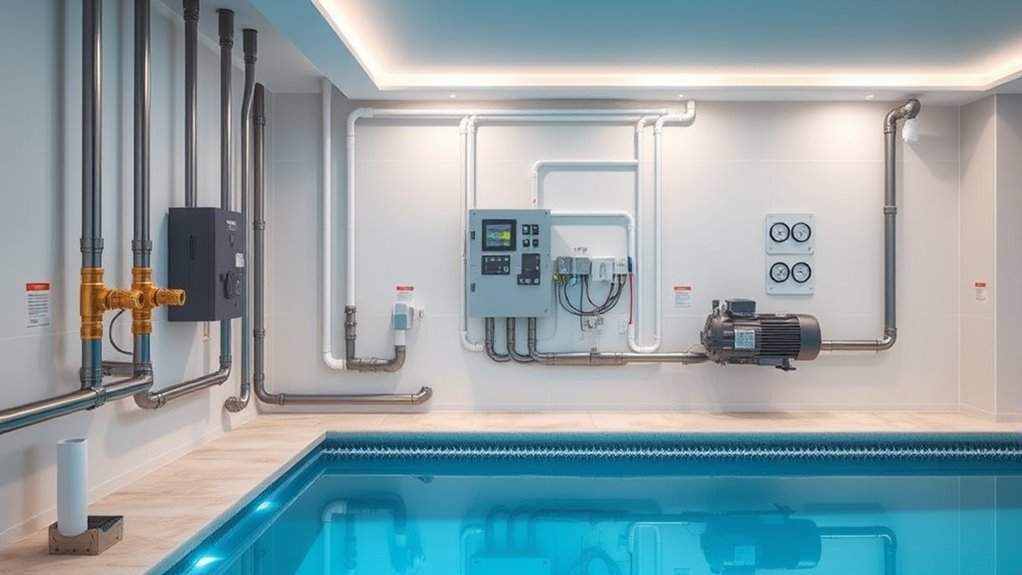
Maintaining your Endless Pool’s systems is essential for reliable operation and quick issue resolution. Regular checks help catch problems early and keep your pool running smoothly. Here’s what to focus on:
- Inspect filters and pumps—look for debris or unusual noises that could signal a clog or malfunction.
- Monitor water chemistry and levels—ensuring proper pH and sanitizer balance prevents corrosion and bacteria growth.
- Test electrical connections and control panels—verify switches and displays work correctly, and address any error messages immediately.
- Regularly review your narcissistic behavior patterns to maintain healthy boundaries and prevent manipulation from affecting your mental well-being.
Frequently Asked Questions
How Often Should I Replace the Filtration System?
You should replace your filtration system every 1 to 2 years, depending on usage and water quality. Regularly clean and maintain the filter to extend its lifespan, but if you notice decreased water flow, persistent odors, or cloudy water despite cleaning, it’s time for a replacement. Proper maintenance ensures your pool stays clean and safe, so stay vigilant and follow the manufacturer’s recommendations for maximum performance.
Can I Install the Pool Indoors or Outdoors?
Yes, you can install your Endless Pool indoors or outdoors. If you choose indoor installation, guarantee proper ventilation and humidity control to prevent mold and damage. For outdoor setups, consider weatherproofing and secure positioning to withstand the elements. Think about space, access to power, and plumbing needs. Both options work well, but you’ll need to plan carefully to meet safety standards and ensure easy maintenance.
What Is the Typical Lifespan of Plumbing Components?
You can expect your plumbing components to last around 10 to 15 years with proper maintenance. While some worry about frequent repairs, regular inspections and cleaning extend their lifespan. Keep an eye out for leaks or corrosion, and address issues promptly. Using high-quality materials and professional installation also helps guarantee your plumbing remains reliable, so you can enjoy your pool without unexpected interruptions.
Are There Specific Electrical Codes I Need to Follow?
Yes, you need to follow local electrical codes when setting up your endless pool. Check with your city or county for specific requirements, which often include using a GFCI outlet for safety and guaranteeing proper grounding. You might also need a dedicated circuit to handle the pool’s power demands. Always hire a licensed electrician to ensure compliance and safety, preventing electrical hazards and future issues.
How Do I Troubleshoot Common Power Issues?
To troubleshoot common power issues, first check if the circuit breaker has tripped and reset it if needed. Make certain the power cord is securely plugged in and look for any visible damage. Test the outlet with another device to confirm it works. If the problem persists, inspect the GFCI outlet for tripping, and consider consulting an electrician to examine wiring and connections for faults.
Conclusion
With the right plumbing and power setup, your endless pool runs smoothly and safely. Sure, it might seem complex at first, but investing time now guarantees hassle-free enjoyment later. Properly sized pipes, reliable pumps, and essential safety features prevent costly repairs and keep your pool in top shape. Don’t let concerns about installation hold you back—trust that with the right planning, you’ll enjoy endless, worry-free water fun for years to come.

